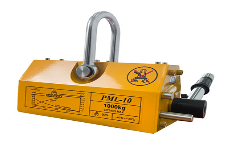Navigation
Menu Center
-
Product category
-
News Online
-
Application scenario

Contact: Manager Han
Tel:+0086 153 8402 0670
Mail:2873282030@qq.com
Add:Room 607, Deya jinzuo, Linping street, Yuhang District, Hangzhou China
The main use of permanent magnet crane
Source:China Kaitaer Official Website Release date:2024-08-10
Permanent magnet suction cups, also known as permanent magnet hoists or permanent magnet cranes, are divided into two types: manual permanent magnet cranes and fully automatic permanent magnet cranes. They use contemporary high-performance Nd-fe-B magnetic material neodymium iron boron, making them smaller in size, lighter in weight, and stronger in suction force. The unique magnetic circuit design results in almost zero residual magnetism. The safety factor is high, and the maximum pull-out force is 2.8-4 times the rated lifting capacity.

The manual permanent magnet crane handle switch is equipped with a safety button, which can be operated with one hand for convenience and safety. V-shaped groove design for lifting bottom surface. The fully automatic permanent magnet crane does not require manual operation of the handle and relies on the lifting control of the electric crane hook to lift and adsorb corresponding round steel and steel plates. It does not require electricity and is safe to use. It is widely used for lifting and transporting steel, installing and transporting flat mechanical components and various molds. A lifting tool suitable for lifting and transporting steel plates at room temperature in industries such as shipbuilding, engineering machinery, and automobiles. Mainly used for connecting with the lifted workpiece during the lifting process (such as matching with loop chain electric hoists, wire rope electric hoists, etc.), used for moving iron plates, blocks, and cylindrical magnetic materials. Easy to operate, safe and reliable, with compact and lightweight results. Widely used in factories, docks, warehouses, and transportation industries. Improve the working conditions for loading, unloading, and handling operations to enhance labor efficiency.






